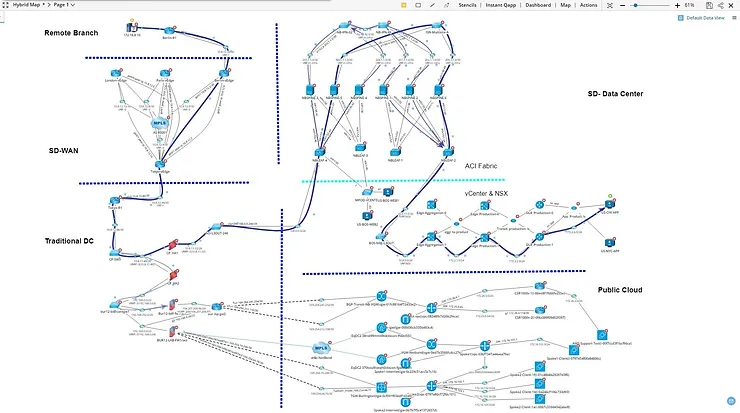Navigating the Challenges of Hybrid Infrastructure Management

Today, the hybrid infrastructure model is the normal, – a mix of on-premises and cloud-based solutions – and has become critical for organizations seeking to balance cost, performance, and flexibility. While hybrid infrastructure offers numerous advantages, the on-going management and operations poses numerous challenges.
Challenges that go well beyond DCIM, like:
-
Where is it?
-
What is its role?
-
What components does it use?
-
How is it performing?
-
What does it depend upon?
-
What does it cost?
-
Is it secure?
The goal of this post is to outline three specific actionable tactics and highlights some of the benefits associated with navigating the challenges of hybrid infrastructure management.
Embrace Automation:
Automation is quickly advancing to from knowing how to code to no-code solutions that simply how engineers can automate their tasks. Using business and technical logic, workflows and playbooks can be easily added into no-code automation solutions to perform work that used to take hours, days, weeks and months.
Benefits:
-
Enhanced Efficiency: Automation streamlines routine tasks, reducing manual effort and minimizing the risk of human error. This ensures that daily work and checks are completed each day, even when someone calls in sick.
-
Consistency and Reliability: Automated processes to ensure consistent deployment and configuration, reducing any variables introduced by manual intervention. Ensuring a more reliable and stable hybrid infrastructure, while reducing the need for tribal knowledge
-
Resource Optimization: By automating resource provisioning and scaling, organizations can optimize their infrastructure utilization. This not only reduces costs but also ensures that resources are allocated dynamically based on actual needs, improving overall resource efficiency.
Actionable Item:
Identify key integration points and deploy no-code automation tools like NetBrain to automate routine tasks, fostering efficiency, consistency, and resource optimization.
Prioritize Comprehensive Security Measures:
As the lines between physical and virtual realms blur, navigating the intricate landscape of cyber threats and vulnerabilities becomes imperative. Commitment to securing your assets and information increases your resilience but serves as the linchpin for security in your ever-evolving hybrid environment.
Benefits:
-
Risk Mitigation: A holistic security strategy minimizes vulnerabilities and mitigates the risk of cyber threats. By implementing robust measures such as multi-factor authentication, encryption, and continuous monitoring, organizations can significantly reduce the likelihood of security breaches.
-
Regulatory Compliance: Comprehensive security measures ensure compliance with industry regulations and data protection standards. This is a crucial and time-consuming endeavor for organizations handling sensitive data.
-
Business Continuity: Effective security measures contribute to business continuity by preventing and mitigating the impact of security incidents. A proactive security stance helps organizations maintain operational resilience, ensuring uninterrupted service delivery.
Actionable Item:
Conduct a security audit if you haven’t done one already to get a baseline. But more importantly, organizations to look at their current monitoring tools to ensure that proper monitoring is in place.
Not to sound like a broken record, but once the baselines are complete and standards set, implement No-Code automation tools like NetBrain, to perform routine security tasks daily.
Build cross functional teams w/ knowledge share:
In a culture where virtual and physical blend together, and as every businesses becomes more of a technology company that do X,Y,Z, instead of a X,Y,Z company that uses technology. Business and IT department and teams need to build and cultivate shared and collaborative environments to properly manage, support and innovate new solutions.
Benefits:
-
Adaptability to Change: A collaborative culture enables cross functional teams to adapt more effectively to changes in the hybrid infrastructure landscape. Cross-functional teams that also share knowledge and experiences are better equipped to navigate evolving technologies.
-
Increased Innovation: When teams can focus on innovation and not daily routine tasks, team members are more likely to exchange ideas and explore innovative solutions to emerging challenges. This promotes a culture of continuous improvement and drives innovation within the organization.
-
Employee Satisfaction and Retention: No one likes doing the same things repeatedly. Automation allows for organizations remove repetitive and yet critical work from team members. Allowing them to invest in skill development and creating opportunities for professional growth. A well-equipped and engaged workforce is more likely to stay committed, reducing turnover and ensuring continuity in expertise.
Actionable Item:
Establish cross-functional teams, encourage knowledge-sharing, and invest in professional development opportunities to build a collaborative culture that enhances adaptability, innovation, and employee satisfaction.
Hopefully by implementing these actionable strategies, organizations can not only address the challenges of hybrid infrastructure management but also unlock significant future benefits for their organizations. Enhanced efficiency, robust security, and a collaborative culture contribute to a well-managed and resilient hybrid infrastructure, positioning organizations for success in an ever-evolving digital landscape.
To learn more about Hybrid management and automation, reach out to our team at Sales@vsolpro.com, or sign up for our communications.

